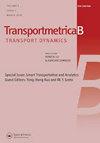离散时空网络中登机口分配与滑行道路径优化:综合模型与状态分析
IF 3.4
2区 工程技术
Q2 TRANSPORTATION
引用次数: 7
摘要
本文章由计算机程序翻译,如有差异,请以英文原文为准。
Optimising Gate assignment and taxiway path in a discrete time–space network: integrated model and state analysis
Airside ground traffic faces increasing congestion pressure with the rapid growth of world air transportation. Airside ground operations, such as gate assignment and taxiway planning, demonstrate excellent results from their own point of view in academia, while the integrated operations are seldom considered. In this paper, we propose an integrated model in a discrete time–space network to simultaneously deal with gate assignment and taxiway planning. An integer programming based on the multi-commodity flow form is formulated to bridge two problems. Practical constraints of the taxiway conflict and gate operation are considered. We also conduct a state analysis among the integrated model, first-come-first-served (FCFS) method, and heuristic approach. The results show that the integrated model can balance the resources between gates and taxiing paths. Sensitivity analyses reveal that the number of flight pairs and connect time impacts gate idle time and aircraft taxi time by directly changing gate assignment.
求助全文
通过发布文献求助,成功后即可免费获取论文全文。
去求助
来源期刊

Transportmetrica B-Transport Dynamics
TRANSPORTATION SCIENCE & TECHNOLOGY-
CiteScore
5.00
自引率
21.40%
发文量
53
期刊介绍:
Transportmetrica B is an international journal that aims to bring together contributions of advanced research in understanding and practical experience in handling the dynamic aspects of transport systems and behavior, and hence the sub-title is set as “Transport Dynamics”.
Transport dynamics can be considered from various scales and scopes ranging from dynamics in traffic flow, travel behavior (e.g. learning process), logistics, transport policy, to traffic control. Thus, the journal welcomes research papers that address transport dynamics from a broad perspective, ranging from theoretical studies to empirical analysis of transport systems or behavior based on actual data.
The scope of Transportmetrica B includes, but is not limited to, the following: dynamic traffic assignment, dynamic transit assignment, dynamic activity-based modeling, applications of system dynamics in transport planning, logistics planning and optimization, traffic flow analysis, dynamic programming in transport modeling and optimization, traffic control, land-use and transport dynamics, day-to-day learning process (model and behavioral studies), time-series analysis of transport data and demand, traffic emission modeling, time-dependent transport policy analysis, transportation network reliability and vulnerability, simulation of traffic system and travel behavior, longitudinal analysis of traveler behavior, etc.
 求助内容:
求助内容: 应助结果提醒方式:
应助结果提醒方式:


